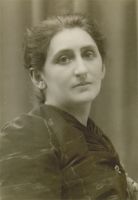Broncia Koller-Pinell
She held a prominent position in the artist circles of her time in Vienna and was acknowledged by critics, elite colleagues and in public, but later fell into oblivion.
Thus she is a striking example, how historical narrative tends to neglect women.
1870 the family moved to Vienna, after the father Saul Pineles – architect fort the military town fortifications in Sanok had had some dispute.
Her father supported Broncia’s talent. At age 18, Broncia started with private painting lessons. At that time women were barred from all art schools and academies.
1885 – 1887 she studied at the “Damenakademie des Münchner Künstlervereins”.
She made many trips in Europe, especially to Paris and studied all international artistic trends of her time. She was the first to bring attributes of French Impressionism into Austrian painting, and all her life she stayed in touch with new trends and movements in painting. Nevertheless, she never copied any of them, but transformed those influences into a distinct style and pictorial language of her own.
Her first public appearance took place in 1888 at the International Art Exhibition in Vienna, her first success in 1892 at the Künstlerhaus in Vienna.
Close association to the Klimt Group, Sezession, Wiener Werkstätten.
Exhibitions 1908 and 1909 at the acclaimed Kunstschau and in 1911 at Vienna’s leading gallery Miethke.
1896 she married Hugo Koller, a Catholic physician and physicist, already pregnant with Rupert. The Kollers became influential patrons (f.e. Egon Schiele). In addition to artists, their salon was frequented by musicians, scholars, philosophers etc., even Siegmund Freud. Her son Rupert married Anna Mahler, daughter of Gustav and Alma. Broncia became surrogate mother to Anna, a painter herself, who had a shaky relationship with Alma. (Broncia disapproved of Alma’s moral conduct - letters to her children advising them to avoid close contact).
Contemporaries describe Broncia as distinguished, temperamental, always lively, encouraging and tolerant. She loved discussions of any kind and controversial points of view.
She was never an active member of the feminist movement, but the fact that she socialized and painted portraits of the three most prominent activists of her time - Rosa Mayreder , Therese Schlesinger and Maria Lang - shows her attitude. Also she had special ties with Lou Andreas Salome.
Likewise, Broncia tried to develop a special feminine quality in her artwork, very visible in her nudes (painting nudes was still fairly scandalous for women), but also in the way she painted interior scenes to convey insight into women’s trapped position. This made it easy later on to reduce her artistic achievements to the output of a painting housewife. Furthermore, interiority was regarded as opposite to Modernism.
A friend: “the talented wife of a prominent husband” (1934).
Apart from painting, she was a master in xylography.
In her diaries she had anticipated First World War, which overshadowed her work to some extent. In the later years of her life, growing anti-Semitism was a big strain on herself and her children.
Saul Pineles had run a textile factory in Oberwaltersdorf. After his death his estate became the Koller family home and famous meeting place for their salon, redesigned and furnished by Josef Hoffmann, Kolo Moser and Broncia herself.
Unfortunately most of the interiors were sold off by later generations, what is left is exhibited in Museum Oberwalterdorf – quote on their homepage:
The painter Albert Paris Gütersloh wrote in his obituary: „ Because she was a woman, Jewish and rich, male and poor people could not acknowledge her worth”.
1961 first memorial exhibition after WW2 in the Austrian State Printing Press, only thanks to the initiative of her daughter Silvia. Silvia also became a painter and in later years she was Broncia’s closest partner for dialogue in artistic matters.
Sources:
- The Memory Factory
- The Forgotten women Artists of Vienna 1900 – Julie M. Johnson
- Baumgartner, Sieglinde. “Broncia Koller-Pinnell, 1863–1934: Eine österreichische Malerin zwischen Dilettantismus und Profession.” Ph.D. diss., Salzburg: 1989.
- Jewish Women’s Archive: http://jwa.org/encyclopedia/article/koller-pinell-broncia
- Barbara Weidle / Ursula Seeber: Anna Mahler: Ich bin in mir selbst zu Hause
- Albrecht Hirschmüller: Siegmund Freud und Broncia Koller-Pinell
Photocredits: Broncia Koller, photograph from1895, copyright expired
Source: Wikipedia http://de.wikipedia.org/wiki/Broncia_Koller-Pinell




